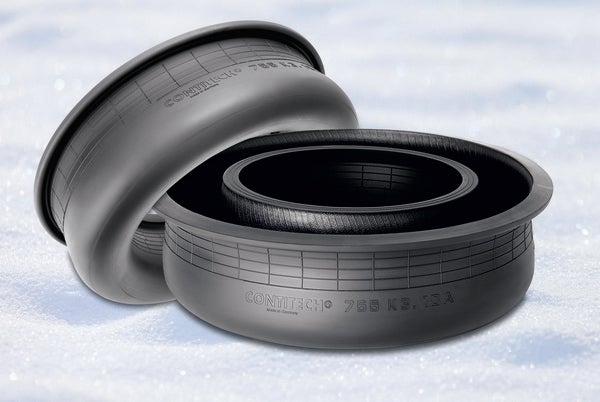
- Novel air spring from ContiTech Railway Engineering stands up to temperatures as low as -50°C
- New material combines the strengths of natural and chloroprene rubber
- First field tests started
Especially hot and cold temperatures place high demands on spring systems in rail vehicles. For extremely cold areas of application, ContiTech has developed the new K air spring. It can withstand temperatures as low as -50°C and is an excellent example of ContiTech’s comprehensive development expertise and its ‘engineering next level’ principle.
"Extensive expertise is required in the development of such temperature-resistant elastomer products," says Friedrich Hoppmann, head of ContiTech Railway Engineering.
With its extensive expertise in materials and its many years of experience in extreme climatic regions, ContiTech is a specialist in the area of temperature-resistant air springs.
Limits of current materials
Due to the extreme climatic conditions, the use of elastomer products in Kazakhstan poses a challenge in endurance. The state’s long railway lines run through various climate zones characterised by different seasonal extremes. An example is the 1,000km route between Almaty and Astana that connects the north and the south. Rail vehicle air springs made from a rubber compound based on natural and chloroprene rubber were used, but after a while, they exhibited signs of wear in the bellows wall.
"As the traditional air spring materials are pushed to their limits under extreme conditions, a new air spring had to be developed," explains Jörg Frohn, head of research and development at ContiTech Railway Engineering.
ContiTech therefore combined the strengths of both materials for the new K air spring. The rubber compounds and the rubber-coated fabric are the result of the research and development work on truck air springs.
The rubber compound used for the inner layer has a crystal transition temperature of almost -60°C, while the compound for the external layer stands out with its particularly high abrasion resistance and high resistance to the effects of ozone, UV rays and other media. Brittleness tests result in no crystallisation at temperatures as low as -50°C. In the wear-behaviour test, the material proved to have doubled the resistance of chloroprene, which is currently used.
Successful compromise
"When developing the extremely cold-resistant air spring, a good compromise was achieved between changes in properties and adapting to the environmental requirements," added Hoppmann.
"This was confirmed by the laboratory tests."
In Hanover, Germany, ContiTech Railway Engineering operates the world’s only accredited laboratory for air-spring systems for rail vehicles, thus underscoring its quality standards. Twelve testing procedures that are important for the rail industry have been certified to DIN EN ISO / IEC 17025. The test laboratory has been fulfilling the highest requirements for many years with certification in accordance with ISO 9001, TS 16949 and IRIS. For measurements at low temperatures, the bellows were tested in a climatic chamber integrated in the test rig.
"ContiTech designed this climatic chamber at the in-house test laboratory specifically for this type of measurement," explains Frohn.
The air spring is pressurised and cooled for at least twelve hours. The new bellows have been successfully used on the Almaty-Astana route since the beginning of 2014.
For more information, please contact ContiTech.
